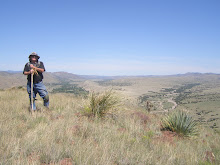Water In The Floridas






Friday, November 19, some of us went to the Florida Mountains ("Little Flower Mountains"), adjacent to Deming, NM. The Floridas are among the most rugged in New Mexico's southwestern
corner. There may be other mountains more rugged than these in this part of NM, but I doubt by
much.
One wonders: why would Apaches live here in rancheria (temporary camp sites that they might
often return to, albeit, with new wickiups constructed upon each return) where water seems so sparse? Did these people not even need water?
Several points need to be raised:
1. In the era before the Civil War, no operation in Mexico or the vast area of the Southwest, before and after the Mexican-American war, cut into the amount of water that had collected in aquifers, streams, rivers, springs, seeps, of the desert country of New Mexico and Arizona and Northern Chihuahua and Sonora, Mexico. Those are the "states" where the Apache lived that I write about;
2. Since no mining or ranching being done by Americans or Hispanics could really "dent" the water table accumulated over millions of years, there was more water available in more places than we see now;
3. Some years in the desert are very wet, some, desperately dry. Apaches, existing in symbiosis with the land and it's water resources, would have been more adept at fine tuning their movements in times of drought;
4. In the rainy season, as well as the winter, when snow melt provided a replenishment of the
water table, the Apaches had many ways of living off the land;
5. Even today, one of the sources of water in the Floridas is found midway down the eastern flank of the Florida Mountains. In fact, there are three or four sources of water along the eastern side of the Floridas (the eastern and northern slopes of the mountain ranges out here are often wetter than the southern and western flanks);
6. The springs shown here were fought over once or twice, by the Apaches and Americans, and likely, the Spanish and Mexicans. Either Mexicans or Americans had built a large rock wall (some obviously not even movable by two or three men, they were so large), above the around
the springs. Later, ranchers additionally built a "box" around the springs where the water would have collected in the rocks, to prevent Apaches from bringing people and horses to the waters to drink with ease);
7. A stone ranch house, tank, walled enclosure that may have served as another structure but with canvas roof, and other additional elements of an "outpost" were erected near the spring. It is possible this ranch house was attacked by Apaches at least one or two times, in raids into the U.S., or on the way out of the U.S., into Mexico;
8. We visited one of these springs and these are the photos. If you're interested in knowing where this one is, write me @ skyminder.eagan805@gmail.com.


0 Comments:
Post a Comment
Subscribe to Post Comments [Atom]
<< Home